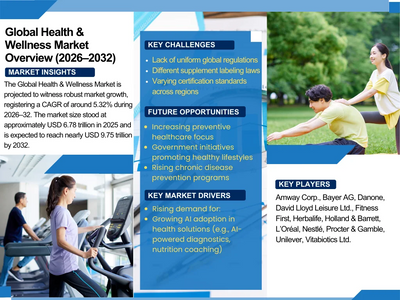Health & Wellness Market 2026-2032: Trends, Drivers & Future Growth Projections
 Lily Desouza
18 Sep, 2025
6 mins read
19
Lily Desouza
18 Sep, 2025
6 mins read
19

Introduction
The health & wellness market is one of the fastest-growing industries in the world, driven by rising consumer awareness, shifting lifestyles, and innovations that combine technology with prevention and holistic well-being. As people increasingly prioritize not just absence of disease but quality of life, mental wellness, nutrition, fitness, and personal care, the industry is expanding across multiple verticals. This blog dives into the market size, key segments, growth drivers, challenges, and what the future holds.
Market Size & Growth Forecast
- The global wellness economy was valued at around USD 9.75 trillion in 2032, up from about USD 6.78 trillion in 2025.
- It is projected to grow at a compound annual growth rate (CAGR) of about 5.32% through 2026–32,
Drivers of Growth
- Preventive Health & Rising Chronic Diseases
- Increasing incidences of chronic conditions (diabetes, heart disease, obesity) are pushing consumers and governments toward prevention rather than just treatment.
- Changing Consumer Behavior & Awareness
- People are more health literate, seeking natural, clean-label, sustainable, personalised products. The rise of wellness apps, fitness tracking wearables, mental health awareness, etc.
- Technology & Digital Wellness
- Telehealth, health-tech devices, online coaching, digital mental health platforms are expanding access and enabling remote, personalized experiences.
- Wellness Tourism & Experiences
- Demand for wellness retreats, spa, mindfulness travel, immersive experiences that combine health + leisure is rising.
- Demographics & Income Growth
- Aging populations in many developed and developing countries; rising disposable incomes especially in Asia Pacific; growing middle class that can spend more on health & wellness goods & services.
Challenges & Restraints
- Cost & Affordability: Many wellness products, services, and experiences are premium priced, limiting reach in lower income segments.
- Regulatory & Quality Assurance Issues: Mislabeling, safety of supplements, standardization concerns. Consumers often skeptical unless there is scientific backing.
- Sustainability Pressures: Demand for sustainable sourcing, packaging, ethics; failure to meet expectations may hurt credibility.
- Fragmented Landscape: Many small players, rapid innovation, which means the market is crowded; differentiation becomes harder.
Opportunities & Emerging Trends
- Personalized Nutrition & Wellness: With data & AI, tailoring diets, supplements, wellness plans specific to genetic, lifestyle & health data.
- Mental Health & Mindfulness: Stress, anxiety, sleep health are becoming as important as physical fitness.
- Eco-Wellness & Sustainability: Natural/organic products; low-impact/spa tourism; waste reduction; clean labels.
- Wearables & Health Monitoring Tech: Smart watches, fitness trackers, biofeedback devices continuing to evolve.
- Integration of Wellness in Daily Life: From workplace wellness to smart homes, wellness is being integrated into everyday environments.
What to Expect: 2026-2032 Outlook
- Continued strong growth, though growth rates may moderate slightly as base becomes larger.
- Asia Pacific will likely see highest growth rate; untapped markets will emerge in Latin America, Middle East & Africa as awareness rises.
- More consolidation: bigger brands acquiring niche wellness brands; more partnerships with health-tech firms.
- Regulatory frameworks becoming stricter around claims, labeling, safety.
Conclusion
The Health & Wellness market is at an inflection point: what was once niche or luxury is increasingly becoming mainstream. As consumers demand more than just products—seeking experiences, authenticity, and measurable benefit—companies that can deliver clean, science-backed, personalized, and sustainable wellness offerings will lead. For businesses and investors, this is a field rich with opportunity—but success will depend on agility, transparency, and deep understanding of evolving consumer expectations.
Written By:
Lily Desouza



Hotels at your convenience
Now choose your stay according to your preference. From finding a place for your dream destination or a mere weekend getaway to business accommodations or brief stay, we have got you covered. Explore hotels as per your mood.





